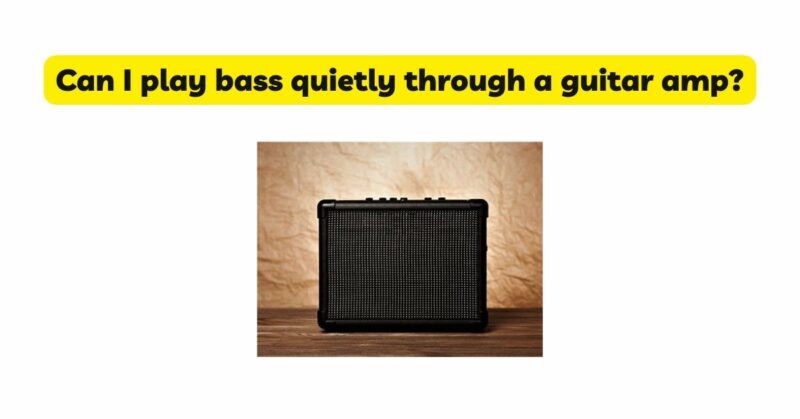For bass players who want to practice or play at lower volume levels, the question often arises: Can I use a guitar amp instead of a dedicated bass amplifier? While guitar amps are not specifically designed for bass frequencies, they can be used at lower volumes for practice purposes. In this article, we will delve into the topic of playing bass quietly through a guitar amp, examining the considerations, limitations, and potential alternatives for achieving optimal results.
Understanding the Differences: Before exploring the possibilities, it’s important to understand the key differences between guitar amps and bass amps. Guitar amplifiers are designed to reproduce the frequencies produced by guitars, which generally fall within the mid to high-frequency range. On the other hand, bass amplifiers are specifically engineered to handle the lower frequencies produced by bass guitars, providing the necessary power and speaker configurations to reproduce the low-end response accurately.
Considerations for Playing Bass through a Guitar Amp:
- Volume Levels: One of the main considerations when playing bass through a guitar amp is volume. Guitar amps are typically lower in wattage compared to bass amps, which means they may not have enough power to handle the lower frequencies of a bass guitar at higher volumes. However, when playing at lower volumes, a guitar amp can be suitable for practice sessions.
- Speaker Response: Another important factor to consider is the speaker response of the guitar amp. Guitar speakers are designed to emphasize mid-range frequencies, which can result in a lack of low-end response when playing bass through them. This may lead to a thinner or less-defined bass tone. Additionally, pushing a guitar amp beyond its intended frequency range can potentially damage the speakers.
- EQ Adjustments: Most guitar amps have a limited EQ range, primarily focused on shaping mid-range frequencies. Bass guitars typically require adjustments in the lower frequencies, which may be lacking on a guitar amp’s EQ controls. However, with careful adjustments, you can still achieve a usable tone by cutting the mid-range frequencies and boosting the bass frequencies.
Alternatives for Quiet Bass Playing:
- Headphone Amplifiers: Consider using a headphone amplifier designed specifically for bass guitars. These devices provide a dedicated headphone output with built-in bass-specific EQ settings, allowing you to practice silently without compromising the tone or damaging the amplifier.
- Modeling Amplifiers: Modeling amplifiers offer a versatile solution for playing bass at lower volumes. These amps simulate various amp and speaker configurations, including those designed for bass, through digital technology. They often come with headphone outputs and built-in effects, providing a convenient and quiet way to practice bass.
- Direct Recording: Instead of using an amplifier, you can connect your bass guitar directly to an audio interface or recording device. This allows you to play silently while monitoring your bass tone through headphones or studio monitors. With recording software or amp simulations, you can achieve a wide range of bass tones without the need for an amplifier.
Conclusion: While using a guitar amp to play bass quietly is possible at lower volumes, it’s important to understand the limitations and potential drawbacks. Guitar amps may lack the power and speaker response required to reproduce the low-end frequencies accurately. However, for practice purposes and playing at lower volumes, they can be a viable option. Alternatively, dedicated headphone amplifiers, modeling amps, or direct recording solutions provide more suitable alternatives for achieving optimal bass tones without compromising volume levels or damaging equipment. Ultimately, the choice depends on your specific needs, budget, and desired tone, so be sure to experiment and find the setup that best suits your playing style and requirements.


